Bungan Head 'Bridge' and Tank Trap during WWII
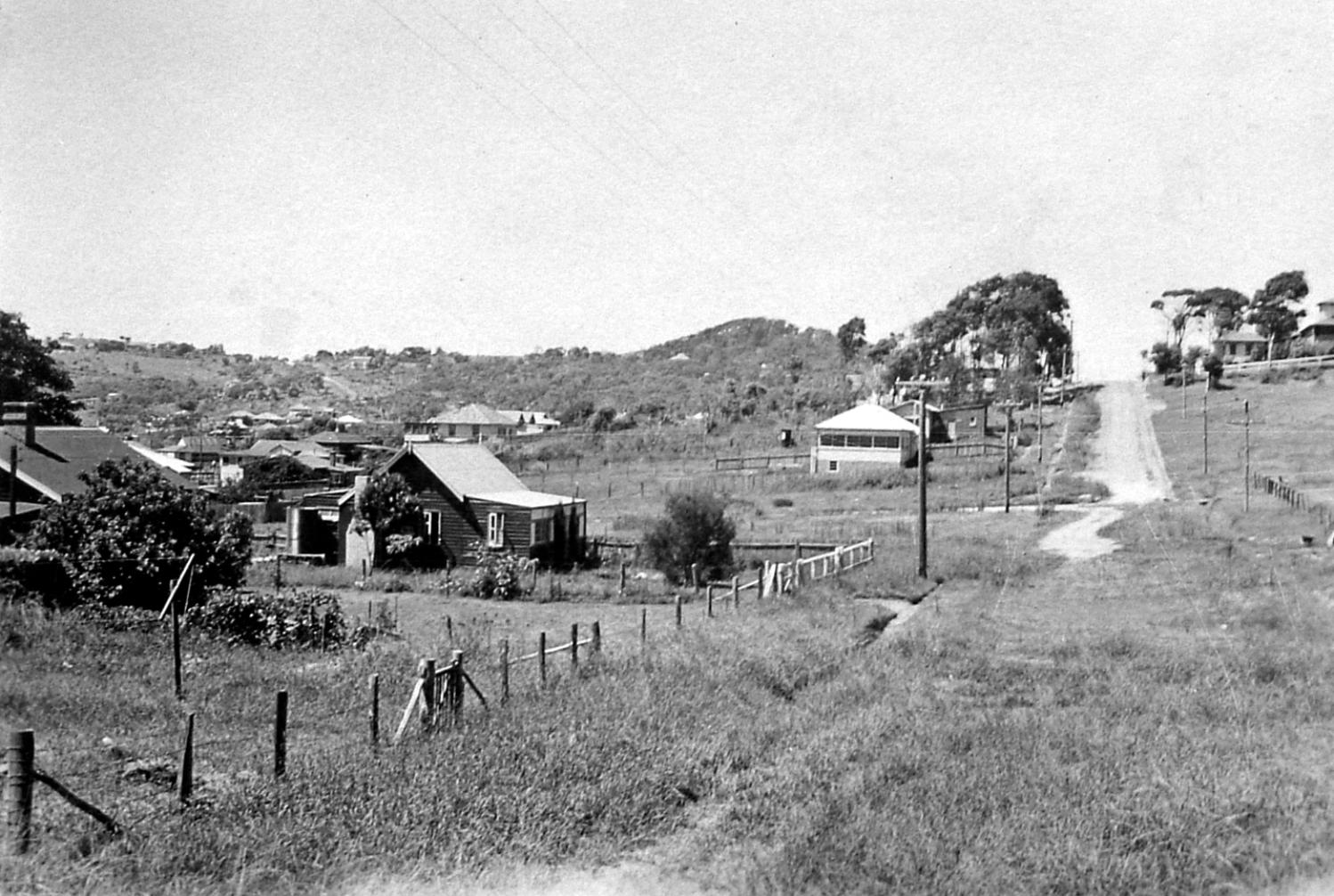
Dear Editor
I have been trying to glean more information about the tank trap at Bungan Head during WWII and read your mention of it in Issue 14, July 2011 and subsequent pages.
During the war I lived at Nullaburra Road, Newport and witnessed the Japanese submarine attack in Sydney Harbour in 1942. My mother and I had been staying overnight with her parents-in-law’s in Cremorne, where we were awakened by a “fireworks display” just before midnight. We stood in awe on the verandah and speculated at the reason for the event, only to discover the truth from the radio in the morning. We returned home by car that day and crossed the familiar (expendable) bridge on Barrenjoey Road near the top of the hill at Bungan Head. Philip Road was constructed years later where the bridge was. My mother told me that it had a dynamite charge permanently attached to it. The tank trap was a ditch about ten metres deep and twenty metres wide intended to stop any armoured vehicular movement south from a Japanese landing in Pittwater or the peninsular.
I think it was only a few days after the submarine attack that the authorities blew up the bridge. This cut off the whole peninsular - Newport, Avalon, Bilgola, Clareville, Whale Beach and Palm Beach. We quickly ran out of food and other supplies until someone thought of transporting by boat from Bayview to Newport Wharf, about 800 metres across Pittwater. All motor boats had been commandeered for the war and there were only a few men available to assist. Women rowed boats loaded with food, fuel drums and other necessities to Newport and returned for the next load. The road bridge was not rebuilt for some time but remained until around 1950. Much later the ditch was filled in and no trace remains today.
I would appreciate hearing other accounts of the bridge, its violent destruction and the aftermath.
Other recollections:
Our home was a small weatherboard holiday cottage in Nullaburra Road. The attached photo shows it near the intersection with Robertson Road. (I think it was called Robertson Parade in those days.) It was among dairy farms at the foot of Bilgola Plateau. Cows frequently strayed into our back yard. It had an outdoor toilet covered by a banana passionfruit vine, a “chip heater” for the bath, a wood-fired “copper” (laundry tub) with hand wringer and a “Kookaburra” electric stove. Kitchen hot water was boiled in a kettle. Perishables were kept in an ice-box.
There was a public telephone outside the general store down the road. Our AWA five-valve radio was on the limits of reception; 2FC and 2BL were the only stations barely receivable. A short walk took us to Newport Beach and the shops. At the northern end of the Barrenjoey Road shops was an office of the Port Jackson and Manly Steamship Company but I never really knew its purpose; the building was seldom open. I think it may have been a bus stop/terminus for a bus from Manly as the company had interests at Palm Beach and Pittwater. We could buy all food items at the general store and butcher. There was an ice-works that served the local domestic ice-boxes. Coupons were required for many foods, clothing and petrol. Like most suburbs, there were few clothing shops, as most preferred the city department stores and tailors.
Bread, milk and ice were all delivered to the home. The milk cart came early so the milk and cream wouldn’t spoil in the sun. My mother left a jug on the doorstep with a note showing the quantity needed, and cash. The baker’s cart was also horse-drawn. Its goods were enclosed but when the hatch was opened the smell of the hot, freshly-baked bread was enticing. The bread (white and brown) was never sliced or wrapped and was carried to the door under sweaty armpits. There were very few men around; many received white feathers in the mail – even those who were medically unfit or were not allowed to enlist as they were required here. Newport was a long way from the city and few made the return trip in a day.
Regards,
Malcolm Tompson
May 28, 2021
Photo: Nullaburra Rd, Newport c1941 - from Malcolm's Family albums
If anyone has any memories to add, please email pittwateronlinenews@live.com.au
Warringah Shire Council records show residents asking for this hole in the road to be repaired ands other tank trap works in 1946/47 and council referring them to the government as their task. Not only did Council not have an enormous amount of funds to expend in a post WW2 environment, many of the places these tank trap works had been built had been resumed by the Army during this conflict, so Council did not have the authority, either, to do any works on these pieces of land.
An example from Narrabeen prior to the cessation of hostilities in the Pacific arena and an example from Europe just days later:
North Narrabeen Progress association, 19/3/45, requesting that Council ask the responsible authorities to remove an "eyesore" consisting of a small amount of barbed wire and posts left near Pittwater Road, Narrabeen, at the entrance to Mullet Creek. (No action authorised.)
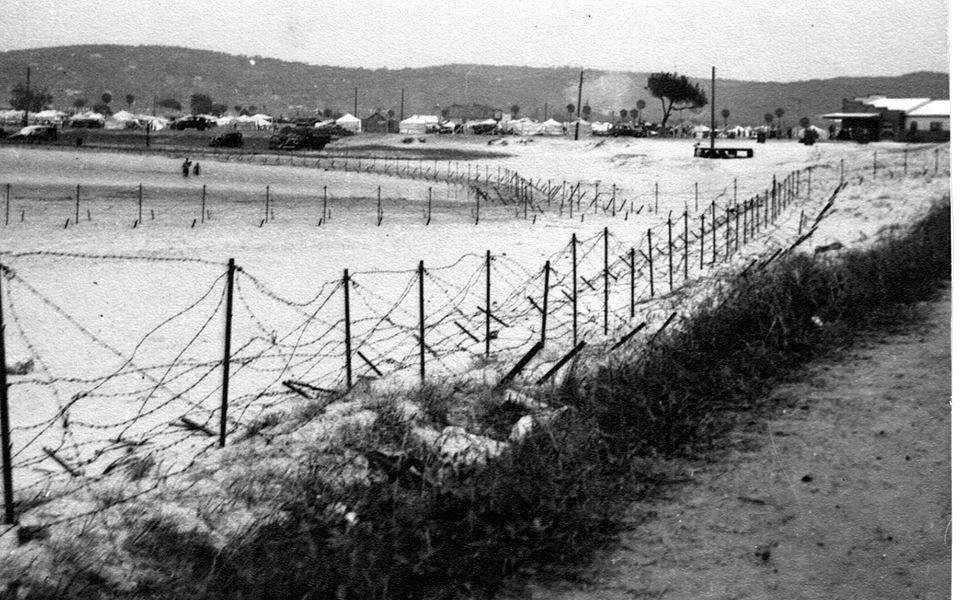
Narrabeen Lagoon's barbed wire defences during WWII - circa 1942
German Civilians Fill In Tank Traps For Allies
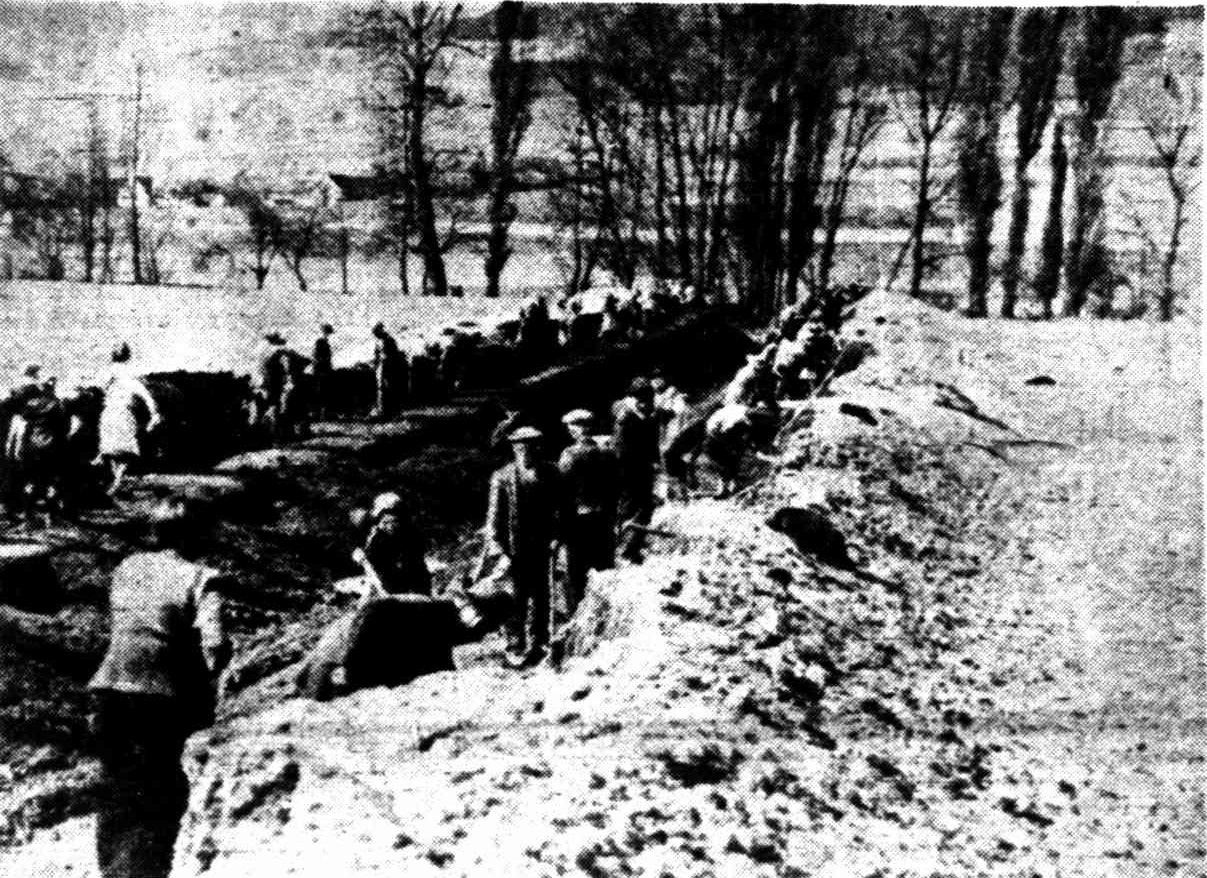
CIVILIANS of Lauterbrecken, Germany, fill in a tank trap on the outskirts of the town to make way for the 3rd U.S. Army Sector. — By Beam Wireless. German Civilians Fill In Tank Traps For Allies (1945, April 4). The Newcastle Sun (NSW : 1918 - 1954), p. 1. Retrieved from http://nla.gov.au/nla.news-article156631505
Germany’s unconditional surrender of its armed forces on Tuesday, May 8th 1945, marking the end of World War II in Europe, is annually marked as VE Day. Japan's acceptance of the Allied demand for unconditional surrender [made on] August 14th 1945 meant that the Second World War was finally over for Australians. The following day, August 15th, is annually commemorated as VP Day.
Similarly, the departments in charge of these were also still having to allocate their funds to tasks deemed more important - such as getting people home from areas of conflict. As Malcolm remembers, it wasn't until the early 1950's that all these repairs were done. Elsewhere, it was almost 10 years later.
Some of these were reused for other purposes; Cedric Vincent Williams, in an interview for a Profile, explained his father, legendary Pittwater sculler, rower, shipwright and sailor Cedric Morton Williams, used them as moorings after the war. At Collaroy some were redeployed to protect homes from beach erosion during storms.
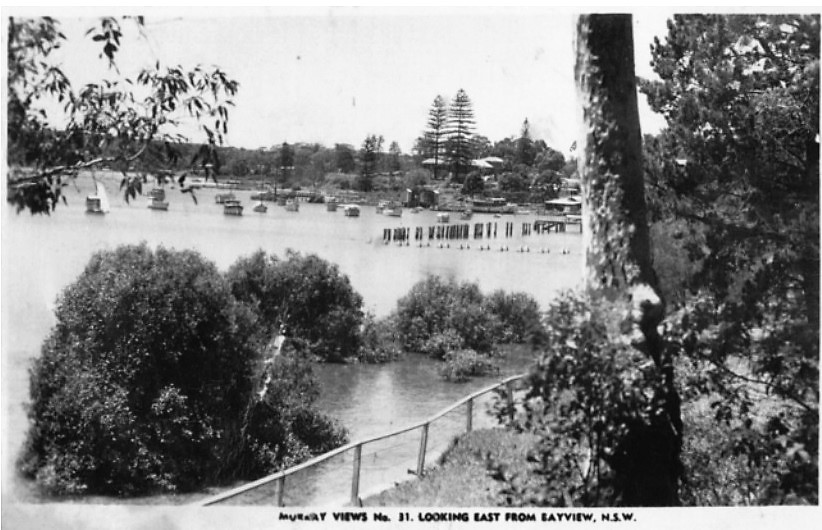
line of tetrahedron tank traps and posts at Bayview - just visible
Bruce Robertson OAM, during his interview for a Profile, shared:
I must say though that during the war there were other hazards causing problems, namely the amount of barbed wire placed there as a deterrent against any potential invasion. They had captured plans you see, plans made by the Japanese to use tanks in an invasion right along our coasts and so tank traps and barbed wire were installed. Every beach had these big concrete triangles, the waterways at Pittwater had them too.We all had to go in and out of these. To go to the surf at Mona Vale during the war you went through two ‘S’s going round and in and out and then in and out again and add to these a series of barbed wire. My main activity then was giving First Aid to people and applying ointments and washing out sand from cuts from barbed wire.
Other local recollections:
"The Second World War proved to be a very quiet time for Newport. Nevertheless, the fear of a Japanese invasion was physically obvious. All the beaches to the south were barricaded with barbed wire and steel posts and there was a tank trap which stretched from Bungan Beach to Pittwater and passed close to the 11 mile store. A timber bridge spanned the tank trap which was bolted together in such a way that if you knocked one bolt out, the whole bridge would fall into the trap. This bridge allowed cars to drive north along Barrenjoey Road, although there was little traffic as petrol rationing was in force. It was mined with explosives for good measure.
The trap was lined on the southern side with large poles which presented a high vertical face to any intruders. From the end of the tank trap there were large concrete blocks shaped like pyramids which extended part of the way up to Winji Jimmi. In the Avenue there was at least one fox hole and all the families living north of the tank trap had to be ready for evacuation at a moment’s notice.
…As Newport had no barbed wire, servicemen came to swim and surf. Mr Vincent’s house at the southern end of Myola Road was requisitioned by the army and fortified with a gun trained on the beach." from - Guy Jennings, The Newport Story 1788-1988. 1987.
Mona Vale - Newport anti-tank ditches 1942-01-20 to 1942-12-04 from NSW State Archives and Records, Part of Series; Murrumbidgee Irrigation Area [M.I.A.] files [Water Resources Commission]
[Works - General - Bungan Beach Defence Work - Army works] - 1942 - 1943 - National Archives of Australia
Betty Morrison of Bungan Beach remembers World War II:
… "Yes, well, of course, we were going to be invaded you see…we knew about the war, of course, but we didn’t know about the coast defence. Mrs Porter sat out on the back, which looked away, their gully went right down to Pittwater, great big trees, beautiful trees. They were sitting at breakfast, all the trees started rocking, all the trees began to shake. Nobody told anybody. This was the secrets of war. Did you ever hear such nonsense! I mean she could have had a fit… Anyway, Mrs Porter rushed down and they said, oh, it was the army and they were going to make a tank trap. So they cut all the trees down, they dug along here, you see, this way going to Pitttwater. The backside of it they made a big wall which the Japs were not going to be able to get up. Having come thousands of miles from Japan.
We had barbed wire everywhere, to say nothing of the army, but the trouble was they didn’t have any weapons. It was absolutely amazing. Bill and I went into hysterics except we were a bit worried what was going to happen. There were a couple of gun emplacements here, some here and some other here, but nothing to put in them!" - Betty Morrison, oral history, 1984.
The Allied Works Council was formed to put in place coastal defences. The concrete tetrahedron tank trap was one of such measures. Around 300 of these tank traps were strategically placed along the shoreline with the first group of eight traps placed on Fairy Bower Beach in Manly. Each trap was about 5 feet high and weighed approximately 2 tonnes and had spikes coming from it. They were embedded in excavated trenches and along shorefronts on the coast and at the estuary mud at Pittwater and at Bayview, were placed in between mangrove trees.
Andrew Amos, in recollections he shared a few years back, said:
World War 2 was still in evidence at Bayview in the early 1950s. During the war all the wharves had been closed to the public and there was an evacuation plan in place should enemy action occur in Pittwater. At the Church Point end of Alexandra Crescent there was a deep excavated trench running up the hill from Church Point Road. This was known as the tank trap and had been constructed during the war in case the Japanese landed tanks further up Pittwater.
Behind our house at the tip of the ridge, near when Kara Crescent is now, there were large pits full of water. My father told me these were pits for anti-aircraft guns and he would have recognised them as such as he served in an anti-aircraft unit during the war. In later years, when I went to Loquat Valley School, we used to cross the tank trap on a narrow bridge made of two large logs laid side by side.
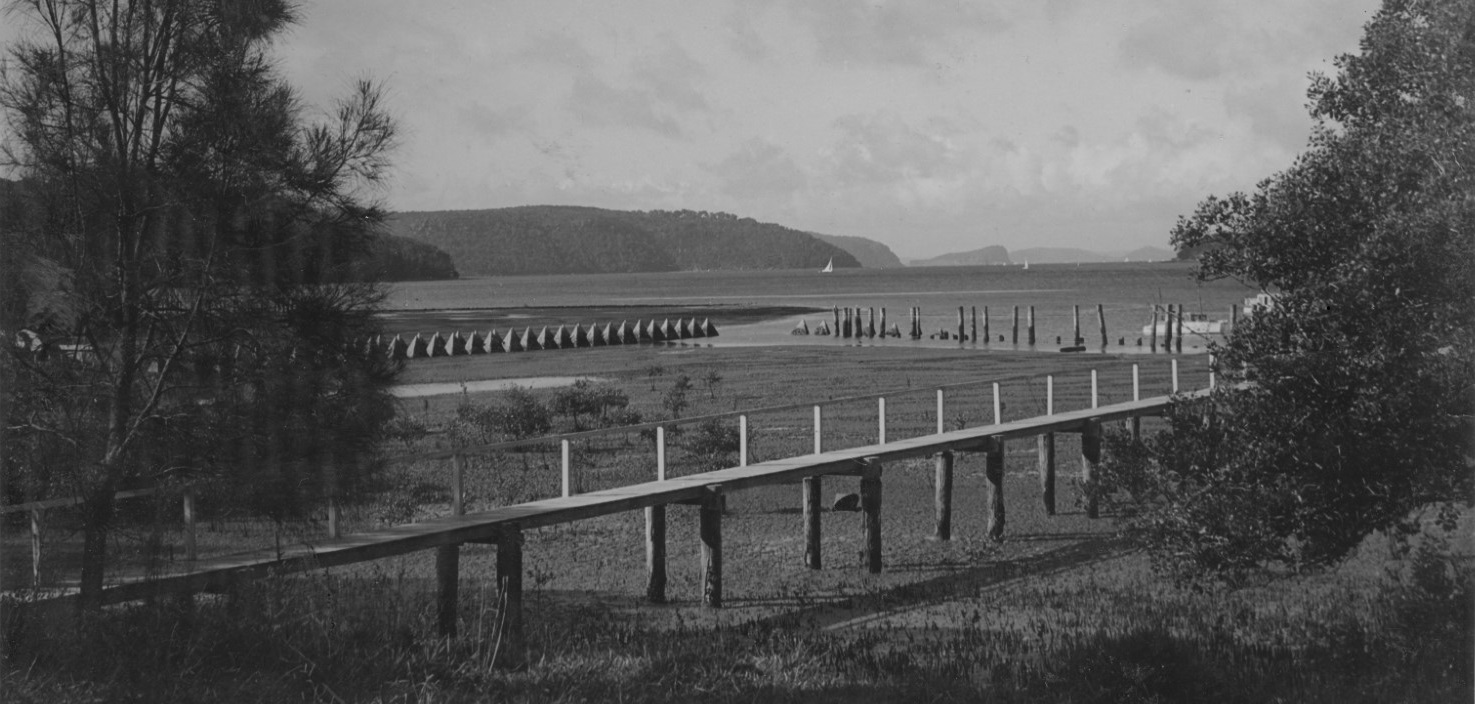
line of tetrahedron tank traps at Bayview
They also created trenches in local roads. During World War II, in 1942, a trench was dug from Bungan Beach, across Pittwater Road and into the mangrove swamp at the head of Winji-Jimini Bay. This effectively cut off all those north of Bungan Beach from Mona Vale.
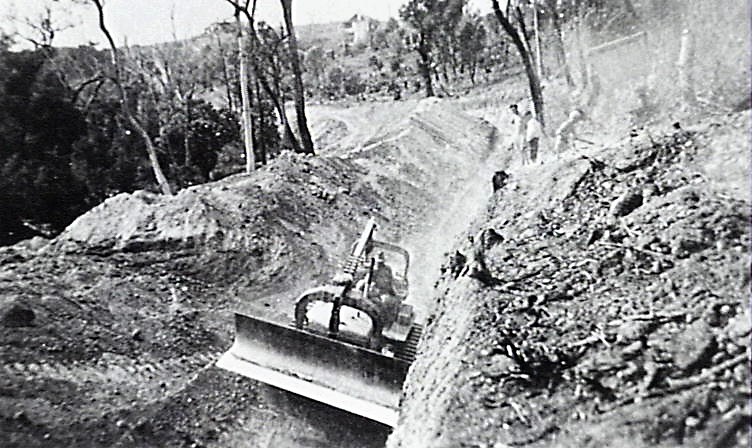
Members of the 18th Infantry Battalion using a bulldozer to excavate trench for tank trap at Mona Vale between Bungan Beach and Philip Road. Photo courtesy Fred Powderley.
At Long Reef the sand dunes to the south of the Golf Course were levelled and the sand was trucked into Sydney city to fill sandbags for protection of buildings from bombing. Unfortunately the removal of sand dunes destroyed a flourishing Little Penguin nesting colony. Some of these returned after hostilities and began nesting under homes from Collaroy to Mona Vale beaches.
Warringah Shire Council records provide:
Tank Traps Minister for the Army, to Mr. Spender, M.P. 7/11/44, regarding the Council's complaint respecting the tank trap at Mona Vale, stating an inspection has revealed that there is no land under cultivation within considerable distance of the tank trap, and it is considered by the appropriate authority that no special hardship is being caused to the small agriculturalists or to residents in the area as result of the tank trap installation. Resolved, - That the Military authorities' be asked to send a representative to meet the Works Committee and "A" Riding Councillors, as the erosion is still taking place.
30/1/1945: The Acting Shire Clerk reported verbally in regard to the tank trap at Mona Vale, and it was resolved that the Military authorities be asked to discuss the matter with the Works Committee and the "A" Riding Councillors.
Main Roads Dept. 28/6/45, replying that the Department has been in touch with the Department of the Army in regard to Tank the removal of the two tank trap bridges on Newport Road and Bayview Road, that the Department's proposals and estimates were forwarded to the Allied Works Council and have been referred to that body to the Department of the Army for consideration and allocation of the necessary funds. "Received"
Chaplain C. Craven-Sande, 6/2/45, requesting approval to a subdivision of Lot 36, Philip Road, into two equal lots. Referred to the Works Committee.
Newport Programs Association, 6/2/45, (a) requesting that the open drain on the northern side of Palm Road near the south-east corner of the park be made safe for pedestrians to cross; (b) requesting the provision of a bi-weekly garbage service in the summer months from October to the end of April; (a) requesting that the stormwater channel at Newport Beach be cleaned out; (d) drawing attention to the mosquito menace in the area, and asking that steps be taken to minimise it by introducing appropriate fish into lagoon, or by monthly treatment; (e) drawing attention to the dumping of large quantities of barbed wire, etc, in the Council quarry at Newport; (f) asking that a notice be erected on the beach intimating that all dogs on the beach must be on leash; (g) emphatically protesting that the Council consenting to the Wins of three structures recently erected in Bardo Road. Council' decisions:- ) (a) that maintenance attention be given; (b) referred to Health & Building Committee; (a) that the drain be opened out (d) that a further report be furnished ; (e) *received"; (f) that the notice be erected;
16/2/46, urging attention to access from Hillcrest Avenue to Barrenjoey Road, where there is not even a sign to warn drivers of the difficult junction. Resolved, - That the the State Members for the district be asked to approach the authorities with a view to having the tank trap attended to
From newspapers - the first one penned by part-timer Avalon Beach resident and former 'A' Riding Councillor Mr. George Killigrew Dunbar, for whom Dunbar Park was named to honour his service to the local community, and, at this stage, the Hon Secretary of the NRMA:
DANGER ON ROADS
- Sir,-We have had a great deal of publicity on road safety, sponsored, I believe, by a Road Safety Council reputedly representative of all authorities and bodies interested in the safe use of our streets and roads.
Might I draw to the notice of all concerned, particularly the Main Roads Department and the military authorities, the tank trap across Barrenjoey Road between Newport and Mona Vale, and the danger created by the bridge across the tank trap on the main road and the hazardous entry of Hillcrest Avenue into the main road?
Are the military authorities and the Main Roads Board waiting for a fatality to occur? There have been accidents already. Motorist residents and users of Hillcrest Avenue have difficulty, even in daylight, in negotiating the turn off the main road, and tradespeople tend to shun the area.
There is no barrier across the end of Hillcrest Avenue to indicate to motorists using the road at night that the road ends in a 20ft drop into the tank trap.
How long must this state of affairs exist?
It is not a matter for the Shire Council.
G. K. DUNBAR,
Sydney. Councillor, Warringah Shire. DANGER ON ROADS (1946, March 13). The Sydney Morning Herald (NSW : 1842 - 1954), p. 2. Retrieved from http://nla.gov.au/nla.news-article17971999
Tank Trap to Go
The tank trap across Barrenjoey-road, Newport, where several accidents have occurred, is to be removed. Tank Trap to Go (1946, March 19). The Sun (Sydney, NSW : 1910 - 1954), p. 7 (LATE FINAL EXTRA). Retrieved from http://nla.gov.au/nla.news-article228791978
TANK TRAPS TO PROTECT HOMES
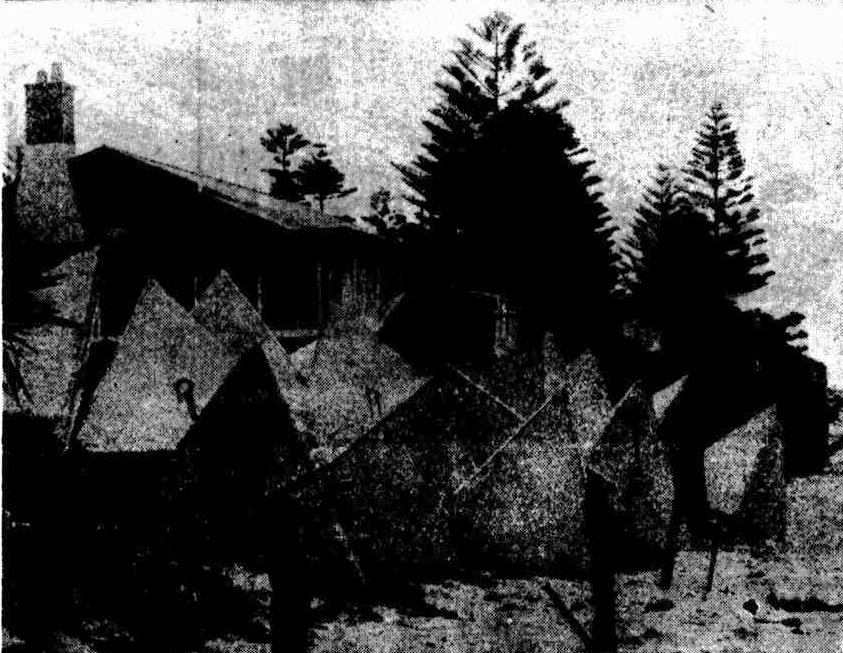
Triangular anti-tank traps have been placed along the beach at Collaroy to prevent washaways of gardens and homes on the waterfront. During heavy storms last year several homes were severely damaged in this area. TANK TRAPS TO PROTECT HOMES (1946, February 14). The Sydney Morning Herald (NSW : 1842 - 1954), , p. 3. Retrieved from http://nla.gov.au/nla.news-article17970399
TANK TRAPS TO PROTECT HOMES
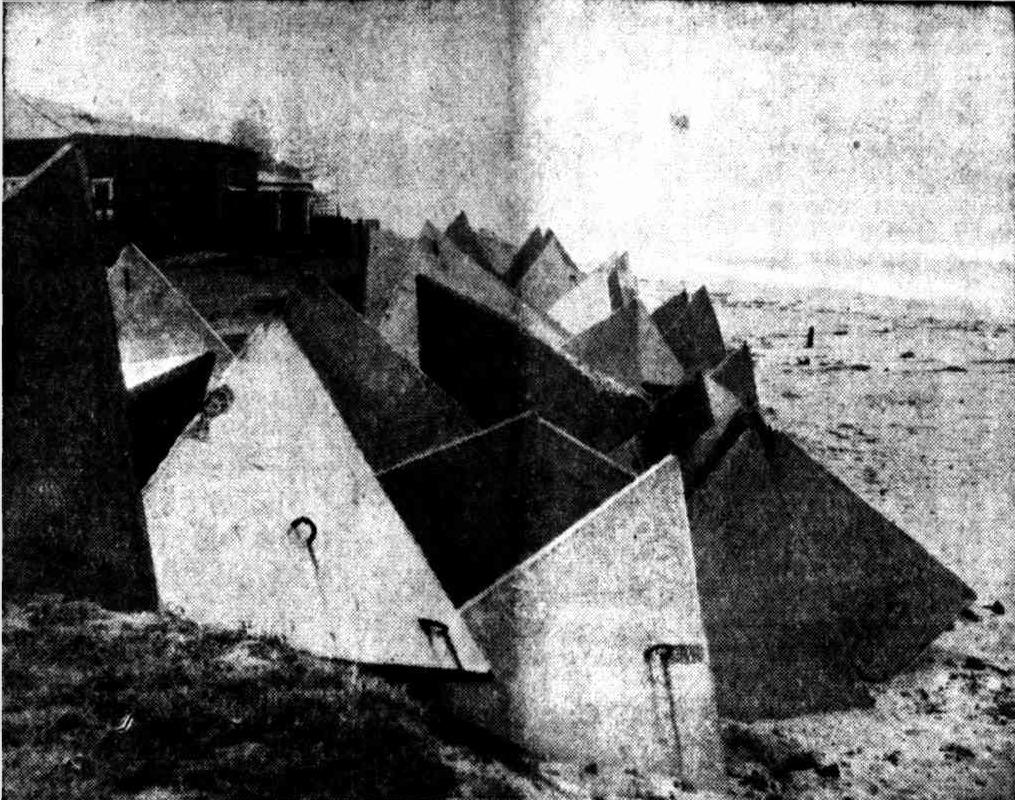
Triangular anti-tank traps have been placed along the beach at Collaroy to prevent washaways of gardens and homes on the waterfront. During heavy storms last year several homes were severely damaged in this area. TANK TRAPS TO PROTECT HOMES (1946, February 15). Daily Advertiser (Wagga Wagga, NSW : 1911 - 1954), p. 1. Retrieved from http://nla.gov.au/nla.news-article145007744
P. C. Spender M.H.R.` 18/5/46, forwarding copy of letter from minister for the army, regarding the tank traps at Barrenjoey Rd. Newport, and the state of access to Hillcrest Ave. to the effect that approval has been given to expenditure for back filling of the ditch replacing the drop bridge, and restoring the original pavement.
Mona Vale Community League. 21/1/I1947, submitting following requests - (a) that Heath Street, Bassett Street East and Surfview Road be repaired; (b) the formation of footpaths in Pittwater Road from Jenkins Street and continuing along Bayview Road to Darley Street; Newport Road from the junction to Seabeach Avenue; and (c) kerbing and guttering for the full length of Seabeach Avenue and that part of Surfview Road facing the beach and dressing sheds; (d) construction of steps from the parking area to the rock pool; (e) completion of road repairs in Vineyard Street west from Macpherson Street to the main road; (f) repairs to timber bridges at Warriewood and Mona Vale; (g) replacement of fence around the Memorial Park' (h) that the regulation governing the time limit for completion of main buildings be more rigidly enforced. Council's decisions were:- s (a) that further representations, with a revised claim, be made to the Army authorities regarding removal of tank traps, etc; (b) to be informed of the Shire Engineer's report that an estimate will be prepared; (c) to be informed that this will be given consideration at a later date; (d) referred to Parks & Reserves Committee; (e) to be informed of the Engineer's report that repairs are done as required; (f) to be informed that work is being done continuously on bridges; .. (g) to be informed that-the fence was removed owing to being in bad repair; (h) referred to Chief
Up the coast tenders were called for their removal and reuse:
TANK TRAPS BLAMED FOR EROSION
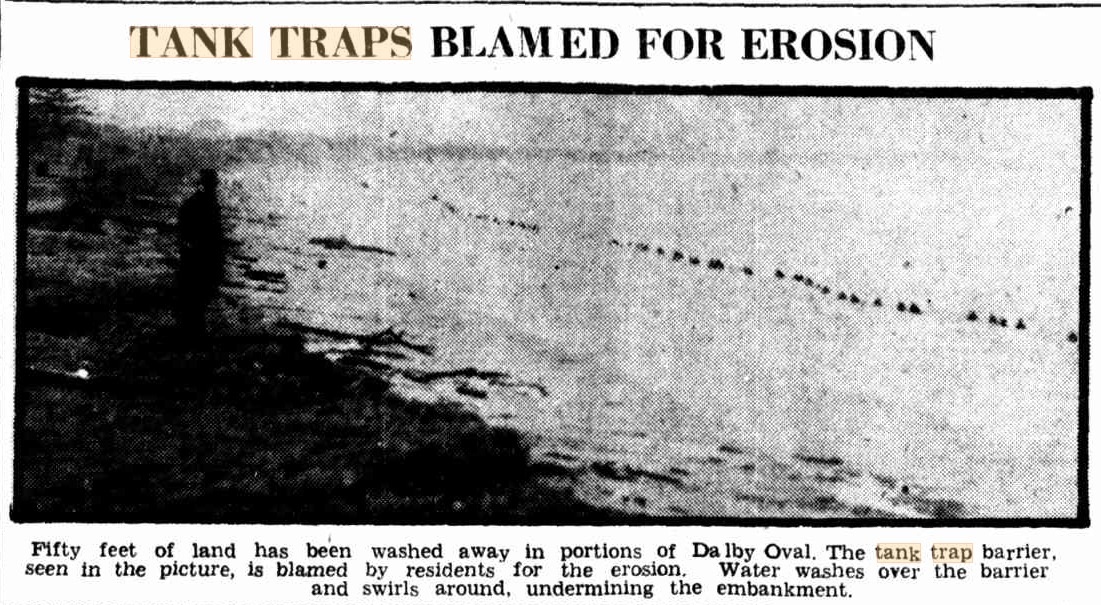
Fifty feet of land has been washed away in portions of Dalby Oval. The tank trap barrier, seen in the picture, is blamed by residents for the erosion. Water washes over the barrier and swirls around, undermining the embankment. TANK TRAPS BLAMED FOR EROSION (1945, June 15). Newcastle Morning Herald and Miners' Advocate (NSW : 1876 - 1954), p. 6. Retrieved from http://nla.gov.au/nla.news-article134998661
Tank-Trap Breakwater Suggested
If the Army removed tetrahedrons from Stockton beach the concrete blocks should be used to build a 'spur' breakwater out from the beach opposite Cardigan Street to prevent further erosion, instead of being dumped on the existing long breakwater, the secretary of Stockton Progress Association (Mr. R. Forward) urged today.
A unit of Royal Australian Engineers this week began experiments to test the practicability of removing the tetrahedrons, which residents contend were largely responsible for erosion alone the seashore. Mr. Forward has expressed the opinion that a short breakwater out from the shore at the point suggested would break the sweep of the sea from the south around the big breakwater and would assist to prevent further erosion. He claims that hundreds of tank traps lying idle at Stockton could be used to build a breakwater in a short time and that this would give 'breathing time' in which permanent measures to prevent further damage from the sea could be worked out and Implemented. Mr. F. H. Hawkins. M.L.A.. said today that the Minister for Works (Mr. Cahill) still had the matter o' Stockton erosion under review and that further investigations were being made.
He added that he had placed Mr Forward's suggestion for a short breakwater before the Public Works Department, and it was being investigated. Tank-Trap Breakwater Suggested (1946, July 5). The Newcastle Sun (NSW : 1918 - 1954), p. 3. Retrieved from http://nla.gov.au/nla.news-article157702278
Surf Boat Hits Tank Trap
Two planks were ripped off Stockton Surf Club's boat when a wave washed it on to spikes on a tank trap as the boat was returning from laying buoys for swimming laces yesterday. Club officials estimate the damage at £20. As the boat was nearing the beach at high tide, the captain, Colin Whyte. tried to steer it through two tank traps. A wave dashed the boat sideways on to the spikes. Repairs will be done by several club members who are shipwrights, but it, is expected that it will be several weeks before the boat is in commission again. Surf Boat Hits Tank Trap (1946, October 28). Newcastle Morning Herald and Miners' Advocate (NSW : 1876 - 1954), p. 2. Retrieved from http://nla.gov.au/nla.news-article133161216
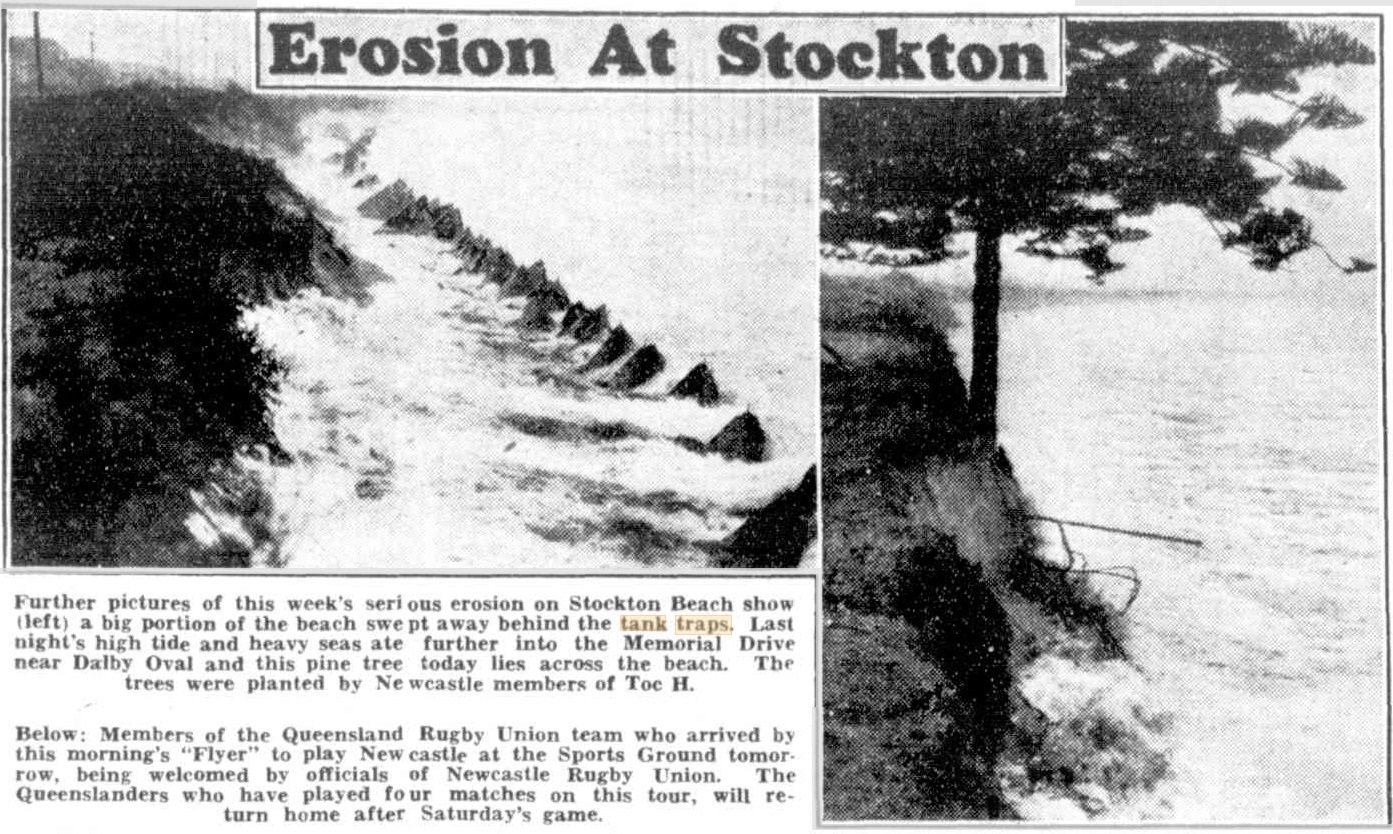
Erosion At Stockton (1948, June 18). The Newcastle Sun (NSW : 1918 - 1954), p. 7. Retrieved from http://nla.gov.au/nla.news-article158141374
Sea Wall At Stockton 'Out Of The Question'
The construction of a sea wall at Stockton to protect the foreshore from further erosion was out of the questio n, the Chief Engineer of the Public Works Department (Mr. J. M. Main) t old the Lord Mayor (Aid. Quinlan) today after an inspection of the area.
Mr. Main made the inspection in company with the Lord Mayor, City Engineer (Mr. Baddeley) arid the department's District Engineer (Mr. Hague). The Chief Engineer made these points: — © Cost of constructing a wall of steel sheet piling or reinforced concrete on a sheet pile foundation along the affected length of the beach would be about £400,000. ? In his opinion there was no danger of the sea breaking through to the harbor even if erosion continued. 0 The protective measures already taken by the City Council if consolidated, would form an effective barrier against further heavy seas. Report To Minister Mr. Main will report to the Minister for Works and Local Government (Mr. Cahill) the results of his inspection today. After examining: the extent of damage to the foreshores from the area adjacent to the Housing commission settlement to the Stockton Surf Club house Mr, Main said that a threat to private property only existed along a comparatively small section of the affected area.
The cost of constructing a wall along the whole length of the beach would be prohibitive. He suggested that the wall of slag, stone and concrete, built in recent weeks by council workmen as a temporary measure, should be strengthened by the placing of a line of several hundred tetrahedrons, at present lying half-buried about 25 feet from the bank, at its base to make a tow. These tetrahedrons in their present position, were quite useless, he added.
Mr. Main also suggested that the wall should be strongly faced with additional tank traps and large spoil concrete. When told by the Lord Mayor that council had already spent more than £1000 and could not afford to spend more, Mr. Main suggested that Mr. Baddeley should prepare an estimate of the cost of work already undertaken and of that proposed by him for submission to the Premier (Mr. McGirr) during his visit to Newcastle next weekend. Sea Wall At Stockton "Out Of The Question" (1948, July 27). The Newcastle Sun (NSW : 1918 - 1954), p. 2. Retrieved from http://nla.gov.au/nla.news-article158268045
TANK TRAP T ENDER APPROVED Acceptance of a tender of £1750 to remove tank traps from near Pitt-street. Stockton, and the Stockton Mental Hospital, and place them at the erosion area opposite Pembroke-street, was recommended by Greater Newcastle Works Committee last night. The full tender, which was from Mr. J. W. Haworth, cnr. Turton and Brisbane Roads, New Lambton, was for £2375, but this included restacking of about 500 tank traps at present near Pembroke-street at a cost of £625. The committee decided to leave these traps where they were. The City Engineer (Mr. Baddeley) said Mr. Haworth's tender was the only one received following the cancellation of the contract of Mr. S. J. Bailey, of Carrington. TANK TRAP TENDER APPROVED (1948, August 11). Newcastle Morning Herald and Miners' Advocate (NSW : 1876 - 1954), p. 3. Retrieved from http://nla.gov.au/nla.news-article140362287
AWARDED £1000 OVER TANK TRAP
A Salt Ash grazier and orchardist, Reginald Sansom, today a as awarded £1000 against the Department of the Interior for damage to his property during the war. The award was made at a sitting of the War Compensation Board in Newcastle at which Mr. J. B. Scobie, S.M.. presided. Sansom claimed compensation for damage to 12 acres of land and fruit trees caused by the erection of a tank trap by the Army in 1941. Mr. J. M. Williams, instructed by Mr. J. M. Ruggero, appeared , for Sansom. AWARDED £1000 OVER TANK TRAP (1948, September 10). The Newcastle Sun (NSW : 1918 - 1954), p. 2. Retrieved from http://nla.gov.au/nla.news-article158267160
Down the coast:
Tank Trap Blocks Removal
The Army Minister (Mr. Francis) has notified the Southern Zone committee he cannot forecast when re moval of tetrahedrons from Lake Illawarra is likely to be complete.
Tetrahedrons are concrete blocks used in Army tank traps when a Japanese invasion was feared during World War 2 Mr. Francis told the committee the work should have been finalised last August, but the contractor's crane had been damaged and working time had been lost. Tank Trap Blocks Removal (1953, January 29). Illawarra Daily Mercury (Wollongong, NSW : 1950 - 1954), p. 6. Retrieved from http://nla.gov.au/nla.news-article134043833
And locally the subject was still in focus in the Summer of 1948-1949:
Mona Vale Will Reopen Course
Mona Vale golf course, which was occupied by the Army during the war, will be reopened for play on January 3. Reconstruction of the course has cost more than £7000. It involved the removal of many tank traps and other military works. A nine-holes layout, 3109 yards in length, skirting the beach, has been constructed. Mona Vale Will Reopen Course (1948, December 17). The Daily Telegraph (Sydney, NSW : 1931 - 1954), p. 17. Retrieved from http://nla.gov.au/nla.news-article248356734
During World War II La Corniche was used as a Red Cross centre for wounded soldiers. In World War II "La Corniche" was commandeered by the Air Force during and used as training ground for recruits. Some sources state it was also used by the Army as an Infantry Training School for NCO's. La Corniche - [Occupation by Australian Military Forces of premises known as 'La Corniche' in Mona Vale, the property of Mr G J McPhee. Includes claim for compensation] Australian Archives Military Records. Property files for sites in NSW hired or acquired for the Department of Defence during World War II
Of then:
I was ordained in 1941, the beginning of `41, and appointed as a curate in the parish of St Faith's, Narrabeen. I was then just two days beyond my twenty-third birthday. The war had commenced, and, during my first appointment at Narrabeen, army camps were being formed in the area, because the threat of invasion was feared. I can recall fences being erected along the sides of the road, so that places like Palm Beach or Bayview could be shut off if need be, and then, when the threat of the Japanese came, the more intense development of army troops in that area. And Canon Tugwell then asked me to become a part-time chaplain to those troops in that area.
The parish of Narrabeen in those days went from Collaroy down to Palm Beach. There were main residential settlements at Collaroy, Narrabeen, but when you went out beyond that to Mona Vale you had mainly twenty-five acre small farms, many glasshouse tomato producers. Beyond Mona Vale, Newport was ... just one hotel in Newport, and mainly accommodation for people coming down to holiday use. Beyond Newport, at Bilgola and at Avalon, and then at Palm Beach, there were just mainly holiday homes, very few permanent residents.
My appointment was to help commence a ministry in that northern part. So I boarded with an old Boer war veteran and his wife, a Mr and Mrs Wilson, who lived in Fermoy Avenue, Bayview. And from there would conduct services in the store at Avalon, where there was little tea-rooms behind the store, and in an estate agent's office at Palm Beach. Subsequently a family by the name of Byle lent us their home for the service at Palm Beach. And my other ministry there was to the troops, which were then being trained by the army, and they had an officers' training unit in a big home at Mona Vale, and my responsibility was to conduct services, and then to have discussions or what they called padre's hours with the intake of recruits.
Canon Charles Henry Sherlock, Chaplain RAAF, interviewed by Gail Winkworth for the Keith Murdoch Sound Archives of Australia in the War of 1939-45
From: http://www.awm.gov.au/transcripts/kmsa/s00572_tran.htm
During WWII the grounds and surrounds were used as a training grounds and the locality of a camp. To stall a feared invasion by Japanese forces, a tank trap was built across the course from Turrimetta to Mona Vale heads and barbed wire entanglements erected next to the beach. The influx of defence forces to the area briefly lifted the Club’s bar sales until the clubhouse was commandeered for use as administration offices and officers’ mess for the nearby army camp.
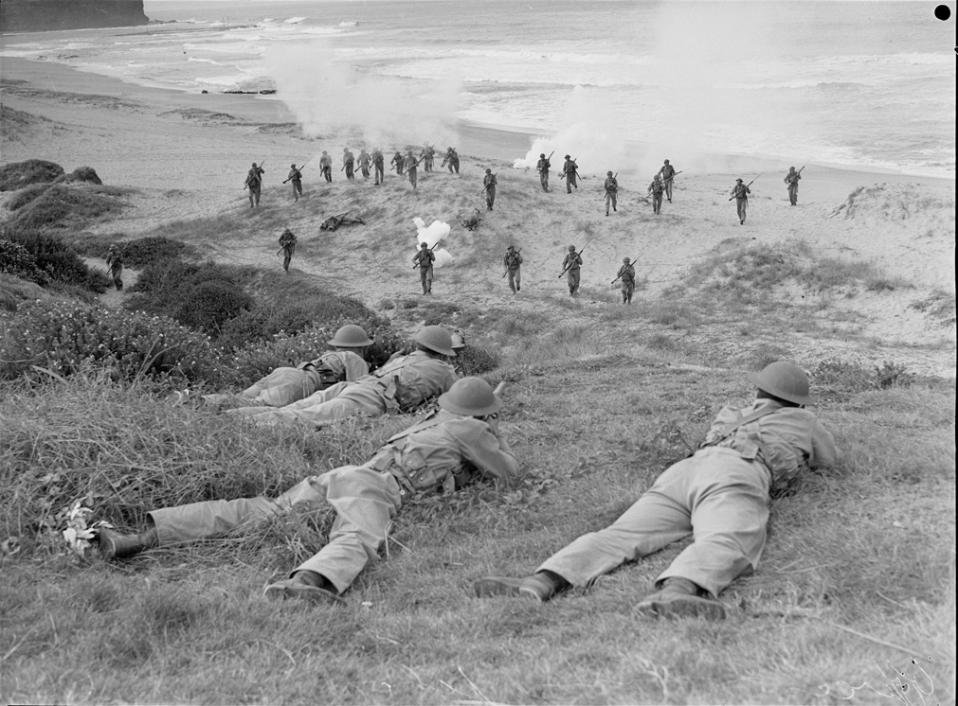
Officers training school Mona Vale, 20 June 1941 photographed by R. Donaldson, Image No.: c21276_0019_c
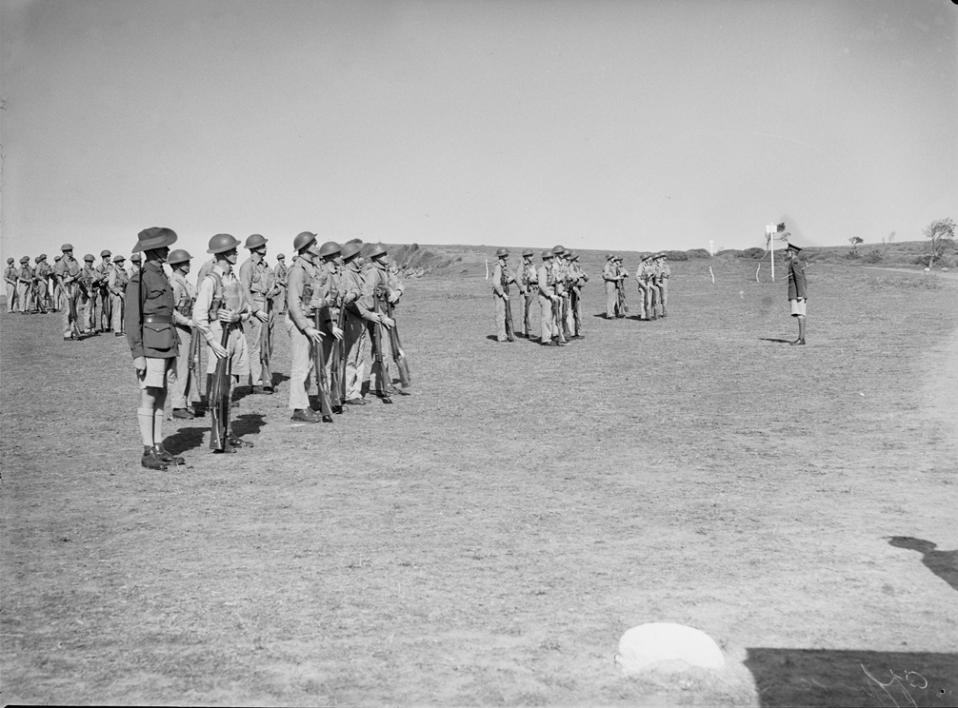
Officers training school Mona Vale, 20 June 1941 photographed by R. Donaldson, Image No.: c21276_0014_c
Spikes in sand menace surfers
BARBED wire and steel spikes left on northern beaches after the war are still a danger to surfers. Army Minister Chambers was warned of the danger more than a year ago. Serious accidents have already occurred. A Sunday Sun reporter yesterday found remains of Army devices on all northern beaches from Queenscliff to Palm Beach.
Rusty iron
Surf club officials said they had treated many children injured by these devices in the last three years. Parts of the concrete relain-ing wall at Queenscliff have not been rebuilt since the Army dug it up for gun em-placements. Pieces of barbed wire are lying on the sand 50 yards from the clubhouse. Inch-thick rusty steel cables on the beach at Harbord has unravelled and broken off into small, dangerous pieces. Jagged ends of a tank-trap are sticking out from the ground.
Wire under sand
Alan Angus, of North Narrabeen Surf Club, said: "During heavy seas waves chew out the sandhills and expose rows of wire entanglements."
Mona Vale storekeeper Arthur Bill said: "A child sliding down beach sand-hills received .a six-inch gash in her thigh."
Mona Vale Surf Club secretary D. Clare said sand had filled much of the 15ft. Mona Vale- Newport tank trap, but supports and cable were still exposed. Spikes in sand menace surfers (1949, January 9). The Sun (Sydney, NSW : 1910 - 1954), p. 5. Retrieved from http://nla.gov.au/nla.news-article230244305
A few more incidentals from Warringah Shire Council's Records:
Ordinary Meeting of 20/4/1959 John Jackson & Co., Solicitors, (letter dated 16/4/59), addressed to the President, requesting Council to re-consider application for re-zoning of residues of lots 20 and 21, D.P. 11651, Barrenjoey Road, Newport for commercial purposes to permit their client, Mr. Dong Fong, to be reinstated thereon by his present landlord, the Department of Main Roads. Their client has lessee of land at corner of Barrenjoey Road and Phillip Road, upon portion of which is erected shop and dwelling known as "Eleven Mile Store" having been resumed by the Department of Main Roads, the remainder having been zoned tentatively as "residential class A", excepting the corner allotment immediately to the rear of their client's premises. Their client is unable to secure a lease of such lands from his former lessor and the Department of Main Roads has intimated its willingness to sell part of the above allotments to Mr. Dong Fong to enable him to carry on his business. The letter continues by stressing the hardship which will befall Mr. Dong Fong by reason of Council's refusal. 25. Resolved - that the letter be "received" and the writer informed that Council's plan is with the Minister and that this Council cannot make any alteration to the plans - any objections or requests for variations should be made direct to the Minister or lodged in a formal manner when the plan is exhibited by the Minister for Local Government. (Crs. Fisher/Reynolds).
13/11/1973; BUSINESS WITHOUT NOTICE - INTRODUCED BY CR. DAWSON. ACQUISITION. OF LAND AT BUNGAN BEACH. Cr. Dawson sought permission to introduce this matter as one of urgency. 6. Resolved - That permission be granted., (Qrs. Dawson/Creagh). Council Resolved - That the matter of land acquisition of the old tank trap property at Bungan Beach be investigated by the Town Planner pending the auction sale of the property, and the Town Planner look into the question of possible acquisition of this property by Council or the State Planning Authority
28/10/1975: Cr. Bur in Can the Shire Clerk and Town Planner report to the first Town Planning Meeting in November the position regarding Council acquisition of the land at Mona Vale known as the "Tank Trap" bounded by Bungan Beach and Barrenjoey Road? As the acquisition would give another access to the Beach, would it be helpful to the dune stabilisation programme to provide this additional access? I will have that looked into.
Meeting of 31/8/1977 (a) T.P. Report 77/367 - File SF348/154-156 Details: Tank trap land - Barrenjoey Road, Newport Possible acquisition by Council for car park and access to Bungan Beach. Council Resolved that no further action be taken at this stage.
Extras from surrounds during that era:
- Pittwater Roads II: Where The Streets Have Your Name - Bungan Beach
- Pittwater Summer Houses: Cooinoo Bungan Beach
- Opportunity To Visit Submarine War Grave Renews Memories Of 75 Years Ago
- Pittwater Reserves - The Green Ways Bungan Beach And Bungan Head Reserves: A Headland Garden
- Pittwater Summer Houses: Ocean Beach House - The Combers, Newport Beach
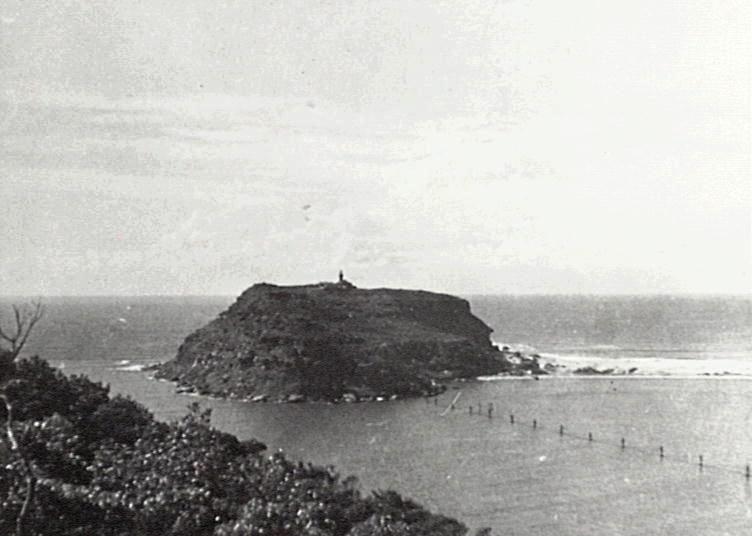
Anti-submarine net between Barrenjoey Headland and West Head. Courtesy Les Wright. Held in MonaVale Library local history unit.
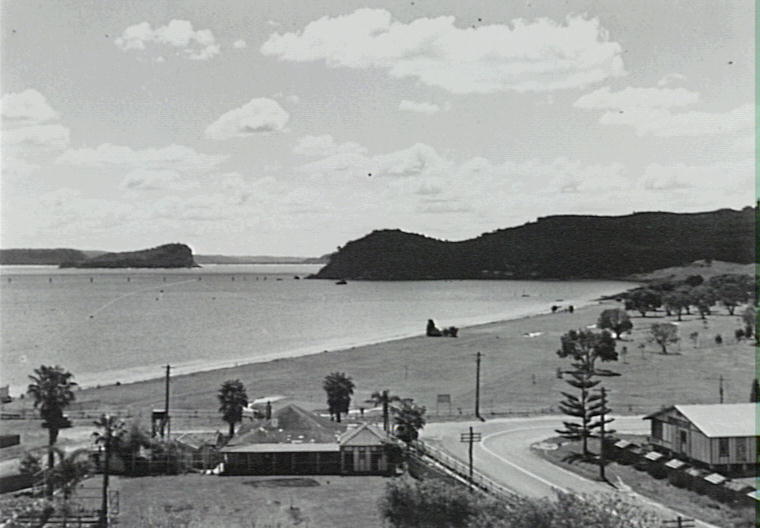
Corner of Barrenjoey Road and Beach Road Palm Beach with Mr B.L. Houghton's house on the left and the Rendezvous Tea Rooms on the right an